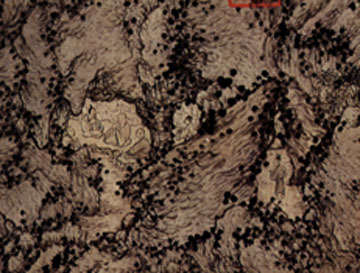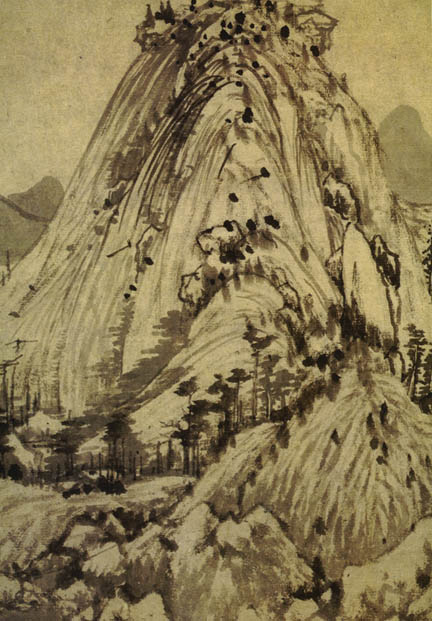|
It became quite common among literati artists of the Yuan
to allude to earlier painting styles in their paintings. They were
creating, in a sense, art historical art, as their paintings did not
refer only to landscapes, but also to the large body of earlier
paintings that their contemporaries collected and critiqued.
Another trait of Yuan literati landscapists is that they did not hide
the process of their painting, but rather allowed the traces of their
brushes to be visible, going considerably further in this direction than
painters of the Song.
In Ming times, the three painters illustrated below, Huang Gongwang,
Ni Zan, and Wang Meng were designated the Four Masters of the Yuan
period (along with Wu Zhen, whose paintings of bamboo appear in a later
section).
From the three paintings illustrated below, do these painters
share much? Do they have similar goals, of employ similar methods?
Or are you struck more by the differences among them?
|
|
 This
artist, Ni
Zan, stripped down his technique to all but the most
essential brushstrokes. His inscription of a poem, by contrast, is
rather lengthy. In it he states that he did the painting as a
present for a friend leaving to take up an official post, to remind him
of the joys of peaceful retirement. This
artist, Ni
Zan, stripped down his technique to all but the most
essential brushstrokes. His inscription of a poem, by contrast, is
rather lengthy. In it he states that he did the painting as a
present for a friend leaving to take up an official post, to remind him
of the joys of peaceful retirement.
What would the inscription have added for viewers
other than the recipient?
For a larger view, click here.
|
|
Ni Zan
(1301-1374), Still Streams and Winter Pines
|
|
SOURCE:
Fu Xinian, ed., Zhongguo meishu quanji, Huihua bian 5: Yuandai
huihua (Beijing: Wenwu chubanshe, 1989), pl. 120, p. 173.
Collection of the National Palace Museum, Beijing. Hanging
scroll, ink on paper, 59.7 x 50.4 cm
|
|
| A larger view: |
 |
| MORE: Ni
Zan was from a wealthy family and until middle age was able to devote
his life to scholarship and artistic pursuits. He built a
pavilion to hold his great library and collection of antiques,
paintings, and calligraphy and entertain his many quests. A
series of floods, droughts, and consequent famine and uprisings
brought this ideal existence to an end as the Yuan dynasty began to
unravel. For twenty years, beginning in 1351, Ni Can wandered
with his family through the southeast, living in a houseboat or
staying with friends.
Scholars read Ni Zan's
paintings of simple, almost barren, unpeopled landscapes as expressive
of a longing for a simpler world. |
|
|

Done in 1366, just two years before the fall of the Yuan
dynasty, this painting represents the villa of a relative of the
painter, Wang Meng (ca. 1309-1385).
| MORE:
Wang Meng (ca. 1308-1385) the youngest of these painters, was
born long after the Song had been defeated and lived into the
Ming dynasty. His adult years were a time of turmoil as
the Mongol government lost control of most areas of China.
After brief service as an official, Wang Meng spent most of his
time in Hangzhou or Suzhou with other poets and artists.
Wang Meng's brushwork
is markedly different from Ni Zan's. He used many
different types of strokes, packed close together to give a
sense of nervous energy.
|
To see a larger view of this dense painting, and to
compare it to the Guo Xi viewed earlier, click
here. [In the guide, below]
| MORE:
By adopting so many of the compositional features of the
monumental landscapes of the Northern Song, such as the dominant
central peak, Wang Meng is able to implicitly compare the
turbulent world he portrays to the stable world of the past.
Where the Guo Xi painting had been traversable, this painting is
full of ambiguities and distortions. Even the brushwork
seems more restless. |
Wang Meng (ca. 1309-1385), Secluded
Dwelling in the Qingbian Mountains
| SOURCE:
Fu Xinian, ed., Zhongguo meishu quanji, Huihua bian 5:
Yuandai huihua (Beijing: Wenwu chubanshe, 1989), pl. 125, p.
179. Collection of the Shanghai Museum. Hanging scroll, ink on paper, 140.6 x 42.2 cm |
|

Compare the composition and brushwork of this painting
to the Guo Xi shown below.
What are the principle differences between the two?
In what ways does Wang Meng's painting seem more a
scholar's painting?
|
|
 |
| SOME
THOUGHTS: By adopting so many of the
compositional features of the monumental
landscapes of the Northern Song, such as the
dominant central peak, Wang Meng is able to
implicitly compare the turbulent world he portrays
to the stable world of the past. Where the
Guo Xi painting had been traversable, this
painting is full of ambiguities and
distortions. Even the brushwork seems more
restless. |
|
|
|
|




 This
artist, Ni
Zan, stripped down his technique to all but the most
essential brushstrokes. His inscription of a poem, by contrast, is
rather lengthy. In it he states that he did the painting as a
present for a friend leaving to take up an official post, to remind him
of the joys of peaceful retirement.
This
artist, Ni
Zan, stripped down his technique to all but the most
essential brushstrokes. His inscription of a poem, by contrast, is
rather lengthy. In it he states that he did the painting as a
present for a friend leaving to take up an official post, to remind him
of the joys of peaceful retirement.












